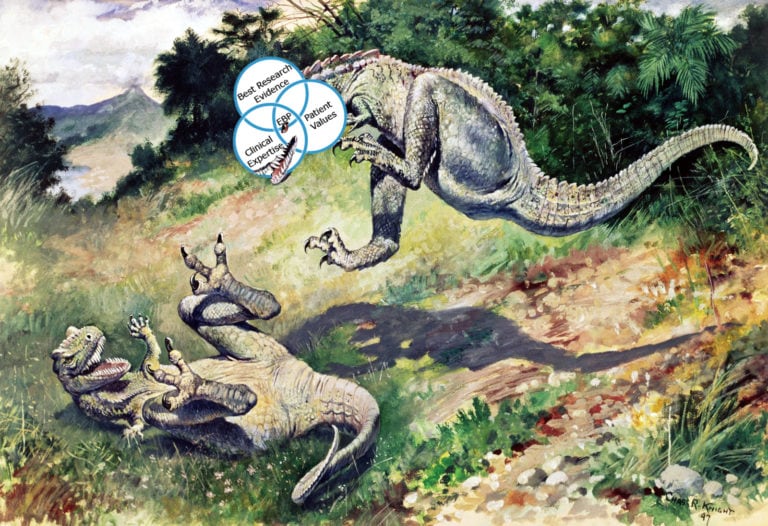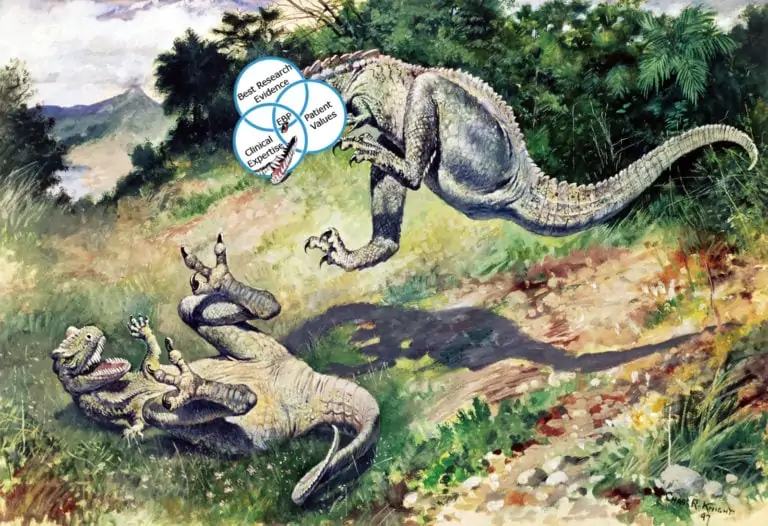How blogging about physiotherapy research can get you fired
How blogging about physiotherapy research can get you fired: Don't be a physiotherapy dinosaur and hold on to outdated evidence!

This is a reblog from Haraldur B. Sigurðsson’ Blog
We are working in this relatively young and rapidly developing profession. We should never halt and be satisfied with our skills. Question yourself and your practice! Evolution beat the dinosaurs – don’t be a dinosaur !;)
“Recently, a blog post I wrote about limitations of spinal manipulation got me fired!
Somehow that doesn’t surprise me, maybe that’s just what happens when you rattle some dinosaur cages. A dinosaur in physiotherapy is someone who is stuck in the past and refuses to update his/her views with new evidence unless it feeds their confirmation bias (Meakins 2015). It’s obviously not a technical term, but a valid description that I am by no means the first one to blog about. It’s also not a blanket description of everyone that graduated before me. It’s not the age that defines the dinosaur, but rather the attitude. There are plenty of physios with many years of experience that still remain open to new ideas and evolve their practice to reflect these ideas.
A dinosaur in physiotherapy is someone who is stuck in the past and refuses to update his/her views with new evidence unless it feeds their confirmation bias
Dinosaurs and their followers are very prevalent today, even among the young folk who work with and are influenced by the older ones. It’s only in recent years that evidence-based physiotherapy is flourishing, facilitated by the explosion of research coupled with social media that allows open discussion, criticism, and dissemination of information by physiotherapists (2).
And, naturally, the dinosaurs are pissed. Not only has almost every therapy they have been providing failed the test, but the whole paradigm of why these treatments should work has failed. Dinosaurs are too deeply committed to these outdated ways of thinking to objectively evaluate the science, too married to old ideas to divorce them. To them, decades of consistent research can be brushed off with “you can feel it working”, or “It’s been working for years!”, or even the abysmally short-sighted “I have a waiting list so I must be doing something right”. They are in an endless loop of using temporary analgesic effects to justify unnecessary or even harmful treatments, confusing immediate patient satisfaction with good clinical outcomes and consciously forcing patients into dependency instead of promoting self-efficacy.
So when I challenged the dinosaur viewpoint by pointing out that there are important limitations to spinal manipulation, I got fired.
Icelandic physiotherapy is undergoing a silent crisis, and in my opinion, dinosaurs are causing it. The average outpatient physio in Iceland sees ~5,5 patients per day (3), which is less than a full-time job. Some of the more popular ones see 18+ patients per day, which means that at the lower end are physios who hardly see any patients at all.
Seeing 18 individual patients per day can’t be considered ethical practice. That means working 9 hours straight, without a break, every day. Making decisions and staying focused becomes difficult. It gets more and more tempting to just do the easiest thing, and that often includes providing passive analgesic therapies. Using active treatments and engaging the patients in a therapeutic union takes the presence of mind and concentration. I would sure not like being patient number 18.
When seeing 18 patients or more per day it gets more and more tempting to just do the easiest thing, and that often includes providing passive analgesic therapie
Discussing treatment options and prognoses – real prognoses, not a unicorn story – may end up with a patient deciding not to attempt an intervention. And that’s ok, people have a right to accept or decline any medical treatment plan. It is our job as physiotherapists to provide patients with the best possible information regarding their condition and work with them to tailor a treatment plan. This may include various therapies if indicated and the patient chooses to use them after discussing them with the physio. But sometimes, this includes one of the hardest decisions a physio makes: recommending no intervention at all.
Other times this may include something unpopular, such as recommending that a patient skips a competition or a planned trip. In that situation, it’s our job to provide the patient with information regarding possible risks associated with participation, but the patient usually makes the final decisions, after all, it’s their risk. If the therapist is greed-driven, working from a business model of more sessions per patient = better, these are surely worthless strategies. In that case, it’s much better to tell the patient „we’ll do everything in our power to make that trip!“ and proceed to throw every therapy under the sun at the patient and hope for the best.

Dinosaurs have indeed become good at milking as many treatment sessions as possible out of every single patient that walks through their door. They take their money by spending countless sessions fixing imaginary blocked sacroiliac joints, softening up tight muscles, and telling stories about remarkable single-session quick fixes.
The same udder-squeezing skill-set results in increasing numbers of patients who realize they spent considerable time and money for little benefit. This in turn creates people who are skeptical about physiotherapy and will just stop booking sessions. It’s a vicious cycle of over-treating causing decreasing numbers of sessions, resulting in increased over-treating.
Evidence-based physiotherapy is – compared to the bloated dinosaur therapy – streamlined, resource-efficient, and requires much fewer treatment sessions on average. It’s a scalpel next to a chainsaw. It’s a breath of fresh air next to a garbage dump. Even the popular dinosaurs can smell the change coming, and they are stressed enough over it to fire people like me for making the patient better informed.
Even patients that receive sham therapy, literally a machine that is turned off, will still improve with treatments (Ilter et al. 2015). This means that every physio will get apparently decent outcomes by simply being equal to the passage of time and a machine turned off.
Every physio will get decent outcomes by simply being equal to the passage of time and the placebo effect
The goal is to provide the patient with information about their condition and the efficacy of possible treatments. Every intervention attempted should have a good chance of performing better than time, and to that end, it’s so important to use the research evidence to weed out useless therapies and set reasonable treatment goals. If no treatment is indicated – the patient will receive information regarding his condition, but no voodoo tricks.

The trend is to increasingly emphasize evidence-based physiotherapy in physiotherapy education. It’s also increasingly emphasized that the knowledge gap between science and the public should be bridged by communicating findings to the public. I got fired for just that, discussing information and evidence – evidence the dinosaurs obviously want to sweep under the rug so they can remain complacent and their clients blissfully ignorant. I believe more physios need to openly support evidence-based physiotherapy and speak up against these outdated methods and together we just might be the meteor that saves physiotherapy.”
References

Haraldur Sigurðsson
MSc in Sports Medicine
NEW BLOG ARTICLES IN YOUR INBOX
Subscribe now and receive a notification once the latest blog article is published.







